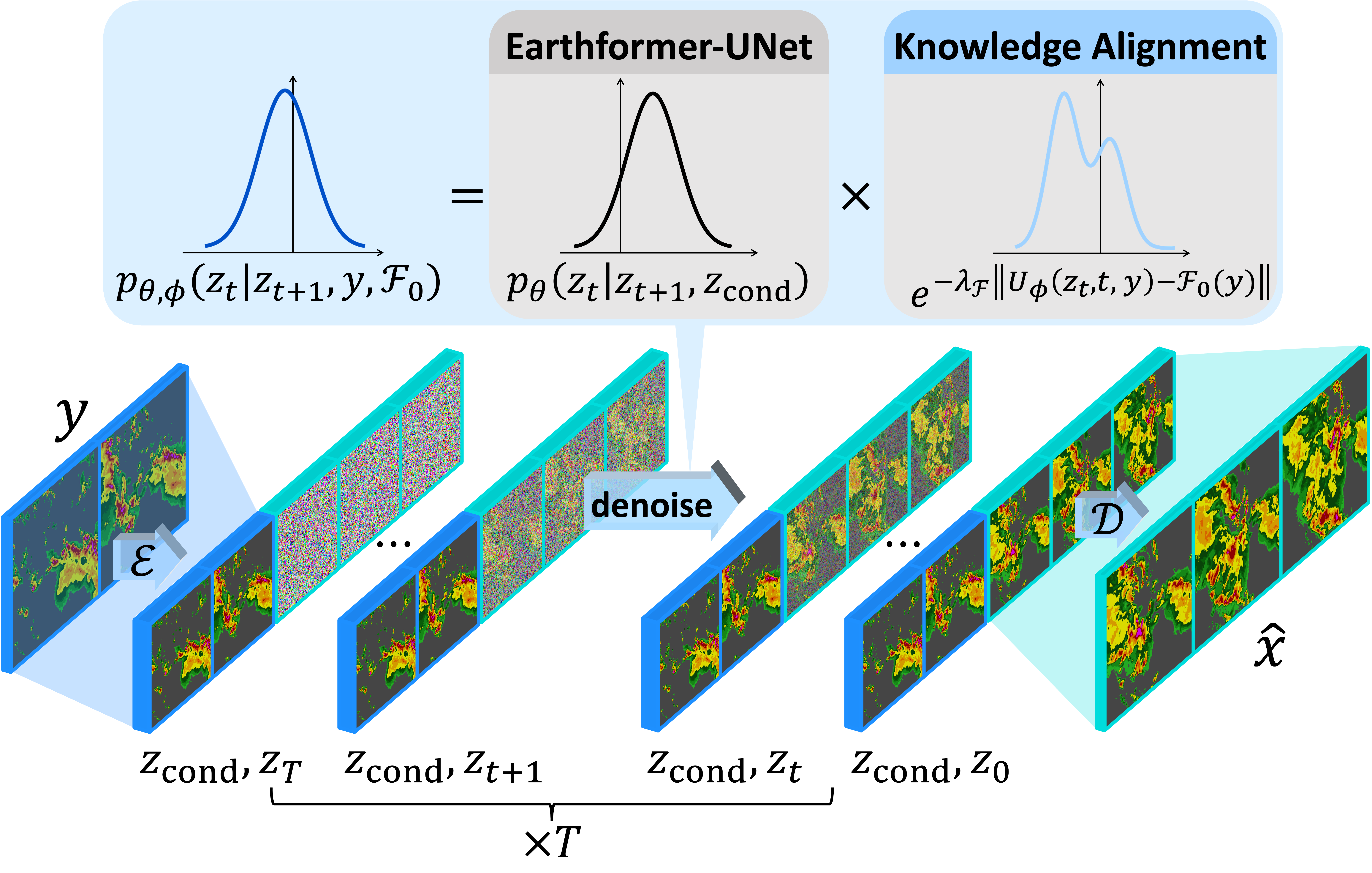PreDiff
By Zhihan Gao, Xingjian Shi, Boran Han, Hao Wang, Xiaoyong Jin, Danielle Maddix Robinson, Yi Zhu, Yuyang Bernie Wang, Mu Li, Dit-Yan Yeung.
This repo is the official implementation of "PreDiff: Precipitation Nowcasting with Latent Diffusion Models" that will appear in NeurIPS 2023.
Introduction
Earth system forecasting has traditionally relied on complex physical models that are computationally expensive and require significant domain expertise. In the past decade, the unprecedented increase in spatiotemporal Earth observation data has enabled data-driven forecasting models using deep learning techniques. These models have shown promise for diverse Earth system forecasting tasks but either struggle with handling uncertainty or neglect domain-specific prior knowledge, resulting in averaging possible futures to blurred forecasts or generating physically implausible predictions. To address these limitations, we propose a two-stage pipeline for probabilistic spatiotemporal forecasting:
- We develop PreDiff, a conditional latent diffusion model capable of probabilistic forecasts.
- We incorporate an explicit knowledge alignment mechanism to align forecasts with domain-specific physical constraints. This is achieved by estimating the deviation from imposed constraints at each denoising step and adjusting the transition distribution accordingly.
We conduct empirical studies on two datasets: N-body MNIST, a synthetic dataset with chaotic behavior, and SEVIR, a real-world precipitation nowcasting dataset. Specifically, we impose the law of conservation of energy in N-body MNIST and anticipated precipitation intensity in SEVIR. Experiments demonstrate the effectiveness of PreDiff in handling uncertainty, incorporating domain-specific prior knowledge, and generating forecasts that exhibit high operational utility.
Overview of PreDiff inference with knowledge alignment.
An observation sequence
Installation
Create Conda environment
conda create --name prediff python=3.10.12
conda activate prediffInstall PyTorch and PyTorch-Lightning with correct CUDA support
python -m pip install torch==2.0.1+cu117 torchvision==0.15.2+cu117 -f https://download.pytorch.org/whl/torch_stable.html
python -m pip install lightning==2.0.9Install PreDiff in dev mode
cd ROOT_DIR/PreDiff
python -m pip install -e . --no-build-isolationDatasets
Storm EVent ImageRy (SEVIR) dataset is a spatiotemporally aligned dataset containing over 10,000 weather events.
The NEXRAD Vertically Integrated Liquid (VIL) mosaics in SEVIR are adopted for benchmarking precipitation nowcasting, i.e., to predict the future VIL up to 60 minutes given 65 minutes context VIL.
The resolution is thus
A visualization example of SEVIR VIL sequence:

To download SEVIR-LR dataset directly from AWS S3, run:
cd ROOT_DIR/PreDiff
python ./scripts/datasets/sevir/download_sevirlr.pyWe can also let the SEVIRLightningDataModule do it for you automatically the first time you call prepare_data().
Alternatively, if you already have the original SEVIR dataset, you may want to get SEVIR-LR by downsampling the original SEVIR. In this case run:
cd ROOT_DIR/PreDiff
ln -s path_to_SEVIR ./datasets/sevir # link to your SEVIR dataset if it is not in `ROOT_DIR/PreDiff/datasets`
python ./scripts/datasets/sevir/downsample_sevir.pyTraining Script and Pretrained Models
Test pretrained PreDiff
Run the following command to download all pretrained weights in advance.
Use --model flag to download a specific pretrained model component.
The available candidates are vae, earthformerunet, alignment, and all.
cd ROOT_DIR/PreDiff
python ./scripts/download_pretrained.py --model allRun the following commands to load pretrained models for inference on SEVIR-LR dataset, following the instruction.
cd ROOT_DIR/PreDiff
MASTER_ADDR=localhost MASTER_PORT=10001 python ./scripts/prediff/sevirlr/train_sevirlr_prediff.py --gpus 2 --pretrained --save tmp_sevirlr_prediffThe results will be saved to directory ROOT_DIR/PreDiff/experiments/tmp_sevirlr_prediff.
Notice that since the inference is extremely time-consuming, the inference is only done for those example sequences for visualization.
To evaluate the whole val/test sets, please set vis.eval_example_only: false in the config.
Train from scratch
Our two-stage pipeline sequentially trains PreDiff and the knowledge alignment network. The training of PreDiff is further decomposed into two sequential phases: training the VAE and the latent Earthformer-UNet. To train all components from scratch, follow these sequential steps:
- Train the VAE.
- Train the latent Earthformer-UNet with the VAE trained in step 1.
- Train the knowledge alignment network with the VAE trained in step 1.
In practice, the training of the knowledge alignment network is independent of the training of the latent Earthformer-UNet.
Therefore, steps 2 and 3 can be performed in parallel.
To achieve this, specify the path to the PyTorch state_dict of the VAE trained in step 1 by setting vae.pretrained_ckpt_path in the corresponding config files.
Find detailed instructions in how to train the models or running inference with our pretrained models in the corresponding script folder.
| Model Component | Script Folder | Config |
|---|---|---|
| VAE | scripts | config |
| Latent Earthformer-UNet | scripts | config |
| Knowledge Alignment Network | scripts | config |
Citing PreDiff
@inproceedings{gao2023prediff,
title={PreDiff: Precipitation Nowcasting with Latent Diffusion Models},
author={Gao, Zhihan and Shi, Xingjian and Han, Boran and Wang, Hao and Jin, Xiaoyong and Robinson, Danielle and Zhu, Yi and Wang, Yuyang and Li, Mu and Yeung, Dit-Yan},
booktitle={NeurIPS},
year={2023}
}
Credits
Third-party libraries:
License
This project is licensed under the Apache-2.0 License.
